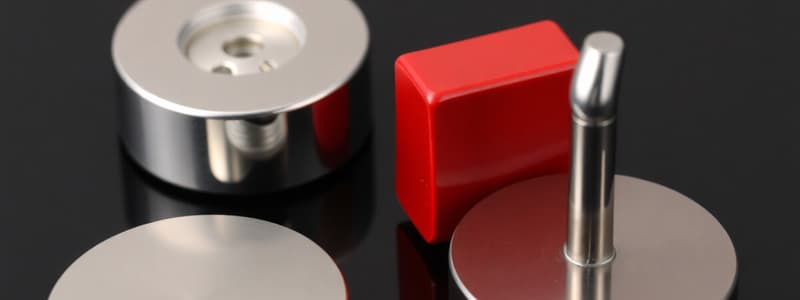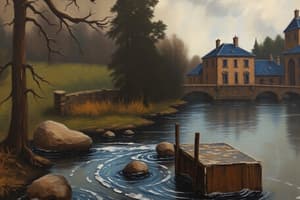Podcast
Questions and Answers
If you roll a ball on the ground, it would slow down after a while and finally stop rolling because of ______
If you roll a ball on the ground, it would slow down after a while and finally stop rolling because of ______
friction
We are able to walk on the ground because of ______
We are able to walk on the ground because of ______
friction
When a force acts on an object, it starts moving if it is at ______
When a force acts on an object, it starts moving if it is at ______
rest
Magnets in telephones, headphones and speakers of help produce ______
Magnets in telephones, headphones and speakers of help produce ______
Electromagnets are ______ magnets.
Electromagnets are ______ magnets.
Magnets can pull or ______ certain materials.
Magnets can pull or ______ certain materials.
The ends of a magnet are called its ______.
The ends of a magnet are called its ______.
Materials such as iron, nickel, cobalt and steel are attracted by magnets. They are called ______ materials.
Materials such as iron, nickel, cobalt and steel are attracted by magnets. They are called ______ materials.
Materials such as gold, silver, aluminium, copper, wood, paper, plastic, glass and clay are not attracted to a magnet. They are called ______ materials.
Materials such as gold, silver, aluminium, copper, wood, paper, plastic, glass and clay are not attracted to a magnet. They are called ______ materials.
When two like poles are brought together, they ______ each other away.
When two like poles are brought together, they ______ each other away.
The South Pole of one magnet ______ the North Pole of the other magnet.
The South Pole of one magnet ______ the North Pole of the other magnet.
When an object is pulled towards a magnet we can say that the magnet ______ the object.
When an object is pulled towards a magnet we can say that the magnet ______ the object.
A ______ is a pull or a push applied on an object.
A ______ is a pull or a push applied on an object.
Flashcards
Friction
Friction
A force that opposes motion between two surfaces in contact.
Force
Force
A push or pull that can cause an object to start moving, stop moving, change direction or change shape.
Electromagnet
Electromagnet
A type of magnet that acts as a magnet only when electricity flows through it. It can be switched on and off.
Magnet
Magnet
Signup and view all the flashcards
Friction in walking
Friction in walking
Signup and view all the flashcards
What is a magnet?
What is a magnet?
Signup and view all the flashcards
What are magnetic materials?
What are magnetic materials?
Signup and view all the flashcards
What are non-magnetic materials?
What are non-magnetic materials?
Signup and view all the flashcards
What are the poles of a magnet?
What are the poles of a magnet?
Signup and view all the flashcards
How do magnet poles interact?
How do magnet poles interact?
Signup and view all the flashcards
What is a force?
What is a force?
Signup and view all the flashcards
What is friction?
What is friction?
Signup and view all the flashcards
What is magnetic force?
What is magnetic force?
Signup and view all the flashcards
Study Notes
What is a Magnet?
- Magnets are special stones or objects that interact with certain metals. They can be natural (like magnetite, also called lodestone) or man-made, typically made of iron or steel.
- Man-made magnets come in various shapes (U-shaped, horseshoe, bar, rod, ring, button magnets) and sizes, depending on their intended use.
Magnet Characteristics
- Magnets attract certain materials, called magnetic materials.
- Magnetic materials include iron, nickel, cobalt, and steel.
- Non-magnetic materials are not attracted to magnets. Examples include gold, silver, aluminum, copper, wood, paper, plastic, glass, and clay.
- Objects like nails and paper clips are made of iron and are therefore attracted to magnets. Steel objects such as locks, spoons, forks, and knives are also magnetic.
Magnet Poles
- Magnets have two poles: a North pole and a South pole.
- The strongest magnetic force is at the poles, weakest at the center.
- A magnet's poles are indicated by 'N' for North and 'S' for South.
- Like poles (N-N or S-S) repel each other.
- Unlike poles (N-S) attract each other.
Force and its Effects
- A force is a push or pull that occurs when objects interact.
- Force can cause objects to move, change speed, change direction, change shape, or stop.
- Friction is a force that slows or stops movement.
- Everyday examples of force include pushing a car, pulling a trolley, squeezing a lemon, kicking a ball, and kneading flour.
Magnet Uses
- Magnets are found in many everyday electrical appliances.
- Magnets help with sound production in telephones, headphones, and speakers.
- Small electromagnets are used in computers and video recorders for data handling.
- Magnets are used in refrigerators to keep the door closed.
Electromagnets
- Electromagnets are temporary magnets that act as magnets only when electricity is flowing through them.
Studying That Suits You
Use AI to generate personalized quizzes and flashcards to suit your learning preferences.





